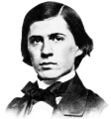Template:Selected anniversaries/April 19: Difference between revisions
No edit summary |
No edit summary |
||
| Line 49: | Line 49: | ||
||1930 – F. Albert Cotton, American chemist and academic (d. 2007) | ||1930 – F. Albert Cotton, American chemist and academic (d. 2007) | ||
||Ernest William Hobson (d. 19 April 1933) was an English mathematician, now remembered mostly for his books, some of which broke new ground in their coverage in English of topics from mathematical analysis. G. H. Hardy wrote, "Although he lived to be 76, he was active almost up to his death; his last book (and perhaps in some ways his best) was published when he was 74. He was a singular exception to the general rule that good mathematicians do their best work when they are young." Pic. | |||
||1945 – The United States Atomic Energy Commission is formed. | ||1945 – The United States Atomic Energy Commission is formed. | ||
Revision as of 06:28, 29 April 2018
1881: Mathematician Karl Mikhailovich Peterson dies. He discovered equations which were subsequently named the Gauss–Codazzi equations, fundamental to the theory of embedded hypersurfaces in a Euclidean space.
1882: Large herd of Flying bison (Bison pterobonasus) migrates from Periphery to New Minneapolis, Canada.
1912: Chemist Glenn T. Seaborg born. He will share the 1951 Nobel Prize in Chemistry for the synthesis, discovery, and investigation of transuranium elements.
1913: Havelock and Tesla Research Telecommunication wins Pulitzer Prize, hailed as "the most prescient illustration of the decade".
1914: Mathematician and philosopher Charles Sanders Peirce dies. He is remembered as "the father of pragmatism".
1932: Mathematician Giuseppe Peano publishes new class of Gnomon algorithm functions which use set theory to detect and prevent crimes against mathematical constants.
2016: Theoretical physicist, theoretical chemist, and Nobel laureate Walter Kohn dies. He developed density functional theory, which makes it possible to calculate quantum mechanical electronic structure by equations involving the electronic density.
2017: Steganographic analysis of Shell unexpectedly reveals "at least four-thousand and ninety six kilobytes" of encrypted data.







